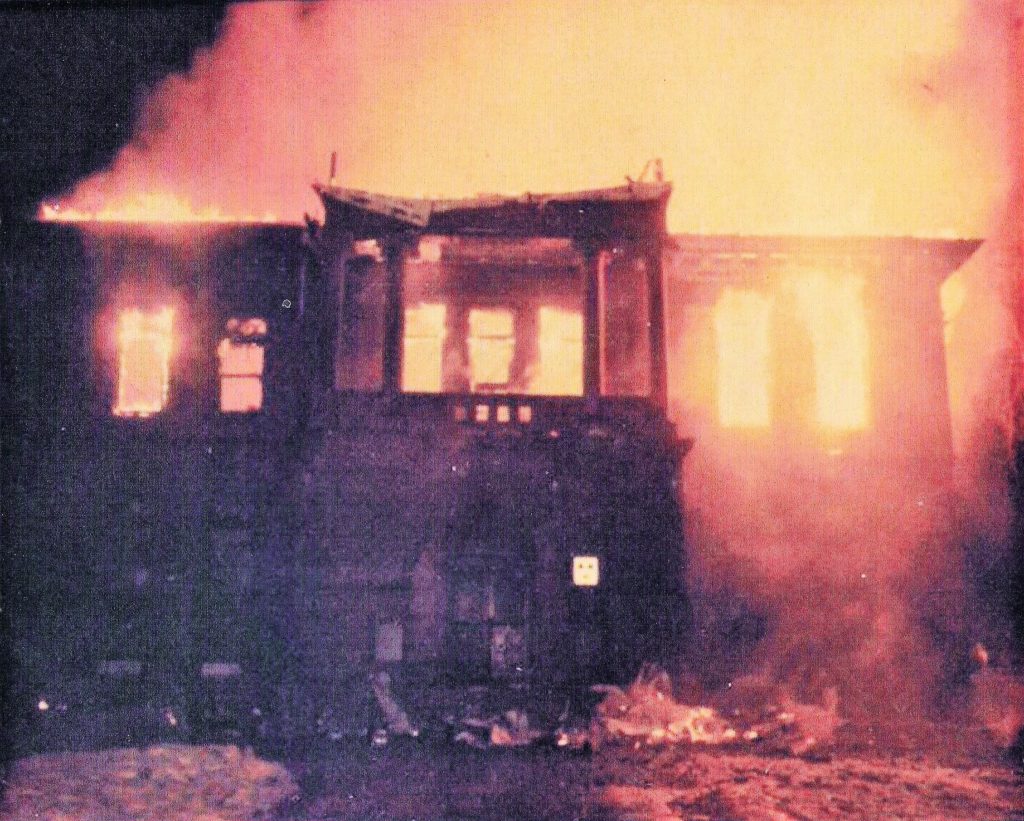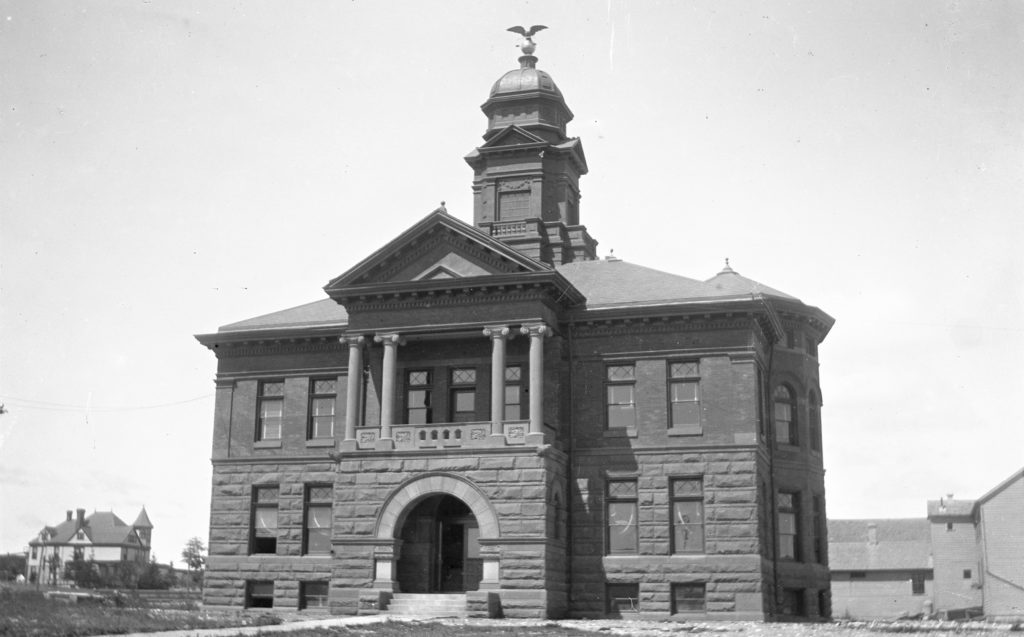
The red sandstone courthouse is seen engulfed in flames in the early morning hours of March 10, 1974. Marcus Bosanic Collection.
For over 70 years, the stately red sandstone courthouse stood at the center of Manistique’s courthouse square. The picturesque structure was erected in 1903 to replace the wood frame courthouse that burned to the ground in March of 1901, after only 16 years of service. The cost for construction of the sandstone building was $36,767 and was officially accepted for use by the county on July 11, 1902. At the time of the fire, the courthouse was insured for $222,000.
The 1974 fire broke out late on a Saturday evening and was first reported at 11:05 pm. When firemen inspected the building and reached the third floor, they found a wall in the northeast corner of the building burned and flames were seen shooting from under the roof. Almost immediately thereafter, heavy smoke drove the firemen from the scene. The cause of the blaze was never determined.
Seven fire trucks and 50 firemen responded to the alarm. Two Manistique fire trucks were aided by units from Escanaba and Gladstone, along with trucks from Mueller and Inwood townships. A canteen was set up in the garage of the Schoolcraft County Jail to provide hot coffee, water and snacks for the men fighting the fire.
A cold north wind fed the flames, causing firemen to keep a watchful eye on the homes located along Lake and Walnut Streets, lest they catch fire from burning embers carried on the wind. A fire truck from Escanaba pumped water onto nearby homes to prevent the spread of the fire. The Schoolcraft County Jail located just a few yards from the courthouse was never in danger as the strong north wind drove sparks and flames away from the facility.

|
Manistique’s red sandstone courthouse as it appeared circa 1905. SCHS photo from a glass plate negative |
The fiery spectacle drew hundreds of residents to the scene. They watched in disbelief as the handsome edifice they had known for so long was inexorably transformed into a hollow, burned-out shell. By midnight, pinkish flames illuminated the sky and the smell of smoke was evident for several blocks around the conflagration. In the crowd that night, former Schoolcraft County Prosecuting Attorney Gottfrid Johnson watched the progress of the flames; just as he had done in 1901 as a nine year old boy, when the previous courthouse was destroyed by fire. What thoughts must have been going through his mind 73 years later?
After daybreak on Sunday morning, all that remained of the former courthouse was a smoldering sandstone skeleton. Firemen and city workers were busy pumping water out of the offices in the basement which escaped the flames while others were at work excavating the vaults in the Schoolcraft County Clerk and Treasurer’s offices. Nothing was saved from the second story courtroom of Circuit Judge William Hood or the third story office of Juvenile Officer John Kasun. The records in both vaults survived the fire without any damage. Very little else was salvaged from the building other than a few filing cabinets and a chair from the office of County Clerk Fred Lesica.
In the aftermath of the fire, temporary quarters were set up for county offices in several different buildings around town including the old Manistique Armory on Chippewa Avenue, the Manistique City Hall, the First National Bank building and the Schoolcraft County Airport terminal building until the new courthouse was ready for occupancy.
The charm of the old sandstone courthouse could never be replaced. Old timers remember the tiled floors and the polished woodwork. The somber and compact courtroom on the second floor seemed a fitting place for the weighty matters of justice to be handed out. The walls of the courtroom were adorned with portraits of former circuit court judges painted by Manistique artist August Klagstad. A narrow stairway led from the jury room to the top of the cupola, and the view of the city was well worth the climb. Down in the basement, the boiler room, sandwiched between the county welfare office and the tax department, also served as a break room for county workers to enjoy a brief respite over a cup of coffee.
On many occasions in the course of doing historical research, I have gone to our present courthouse to examine records and documents from the 1880s and 90s. The staff in the various offices have always been most kind and helpful in finding the material I am seeking. To add to my gratitude, I know that these irreplaceable files have survived not one—but two courthouse fires. Sometimes we must count our blessings.
